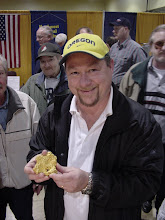Tuesday, February 28, 2006
Great Gravel!
February 25th turned out to be an excellent day to mount an expedition on the beach gravel deposits at Road's End, just north of Lincoln City, Oregon. Although I had visions of visiting several other locations, this was the extent of my collecting for the weekend.
It turned out better than I thought. The sands were completely washed away in many places, exposing Astoria Formation bedrock for 200 yards leading north to the headland at Road's End. The Miocene-aged Astoria bed are tilted at about a 40 degree angle here, and sit unconformably against basalt and basaltic stacks that are highly resistant. The first igneous rocks look like a pyroclastic hodge-podge of angular clasts cemented into a dark host, but further out into the waves the rocks are stricter basalt, dark and dense.
Once past the headland, there is a small cove that on this day was covered with gravels. Usually the bulk of the gravels are little pea-sized rough, but this day there were cobbles piled up in places. Several stretches of big pebbles filled in the holes. Sand, mercifully, was almost hidden from view.
The pickings were excellent right away. I found agates, both red and green jasper, and some nice yellow-red jasper that I know from experience takes a good polish. I didn't find any bloodstone -- green jasper with red spots -- but I found much more petrified wood than usual. I also picked up some good agates that were trending in the direction of carnelian. In about 75 minutes I had about ten pounds of rough, and it won't take a month on the biggest grit to get it smoothed out.
I highly recommend this spot. The kids can play in the tide pools and toss rocks in the waves, the abundance of good tumbling material is staggering, and it's a bit of an adventure to get in there.
February 25th turned out to be an excellent day to mount an expedition on the beach gravel deposits at Road's End, just north of Lincoln City, Oregon. Although I had visions of visiting several other locations, this was the extent of my collecting for the weekend.
It turned out better than I thought. The sands were completely washed away in many places, exposing Astoria Formation bedrock for 200 yards leading north to the headland at Road's End. The Miocene-aged Astoria bed are tilted at about a 40 degree angle here, and sit unconformably against basalt and basaltic stacks that are highly resistant. The first igneous rocks look like a pyroclastic hodge-podge of angular clasts cemented into a dark host, but further out into the waves the rocks are stricter basalt, dark and dense.
Once past the headland, there is a small cove that on this day was covered with gravels. Usually the bulk of the gravels are little pea-sized rough, but this day there were cobbles piled up in places. Several stretches of big pebbles filled in the holes. Sand, mercifully, was almost hidden from view.
The pickings were excellent right away. I found agates, both red and green jasper, and some nice yellow-red jasper that I know from experience takes a good polish. I didn't find any bloodstone -- green jasper with red spots -- but I found much more petrified wood than usual. I also picked up some good agates that were trending in the direction of carnelian. In about 75 minutes I had about ten pounds of rough, and it won't take a month on the biggest grit to get it smoothed out.
I highly recommend this spot. The kids can play in the tide pools and toss rocks in the waves, the abundance of good tumbling material is staggering, and it's a bit of an adventure to get in there.
